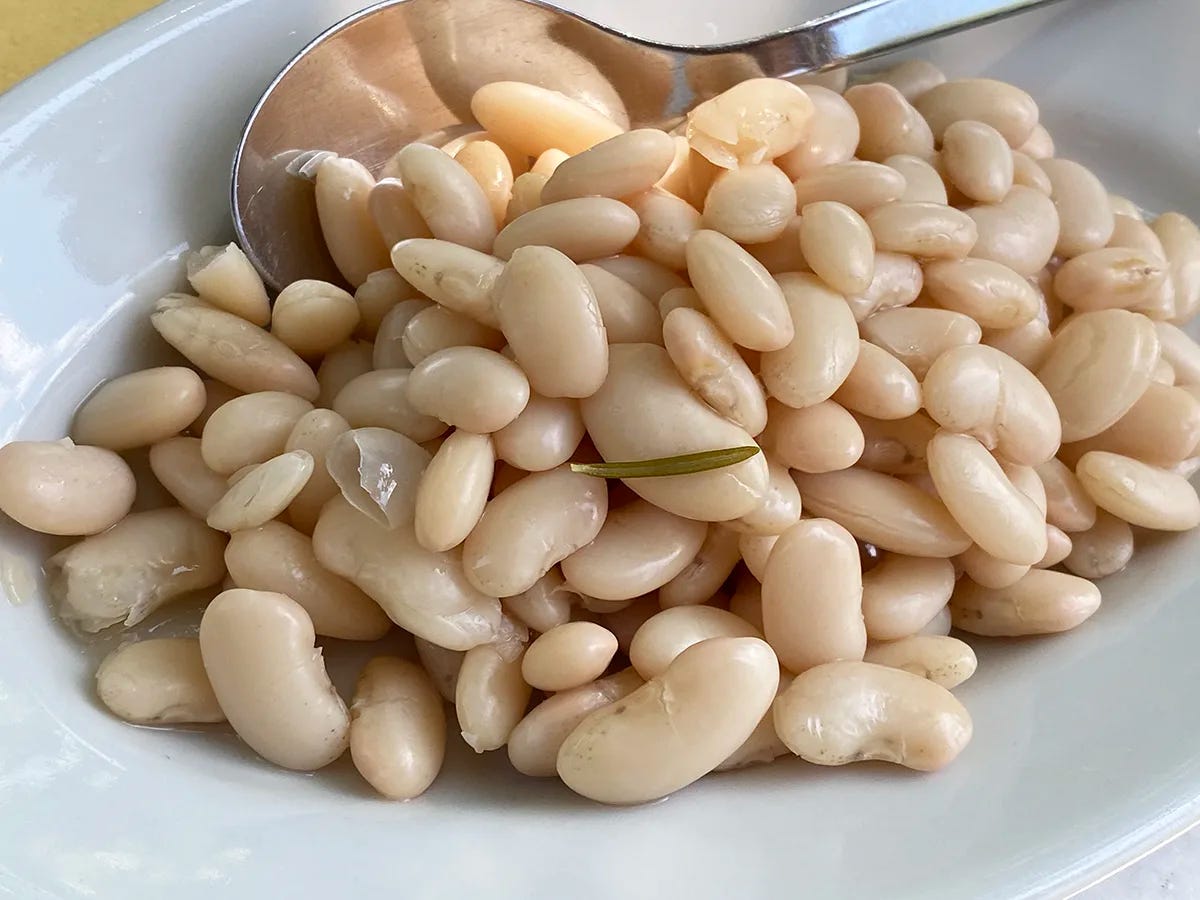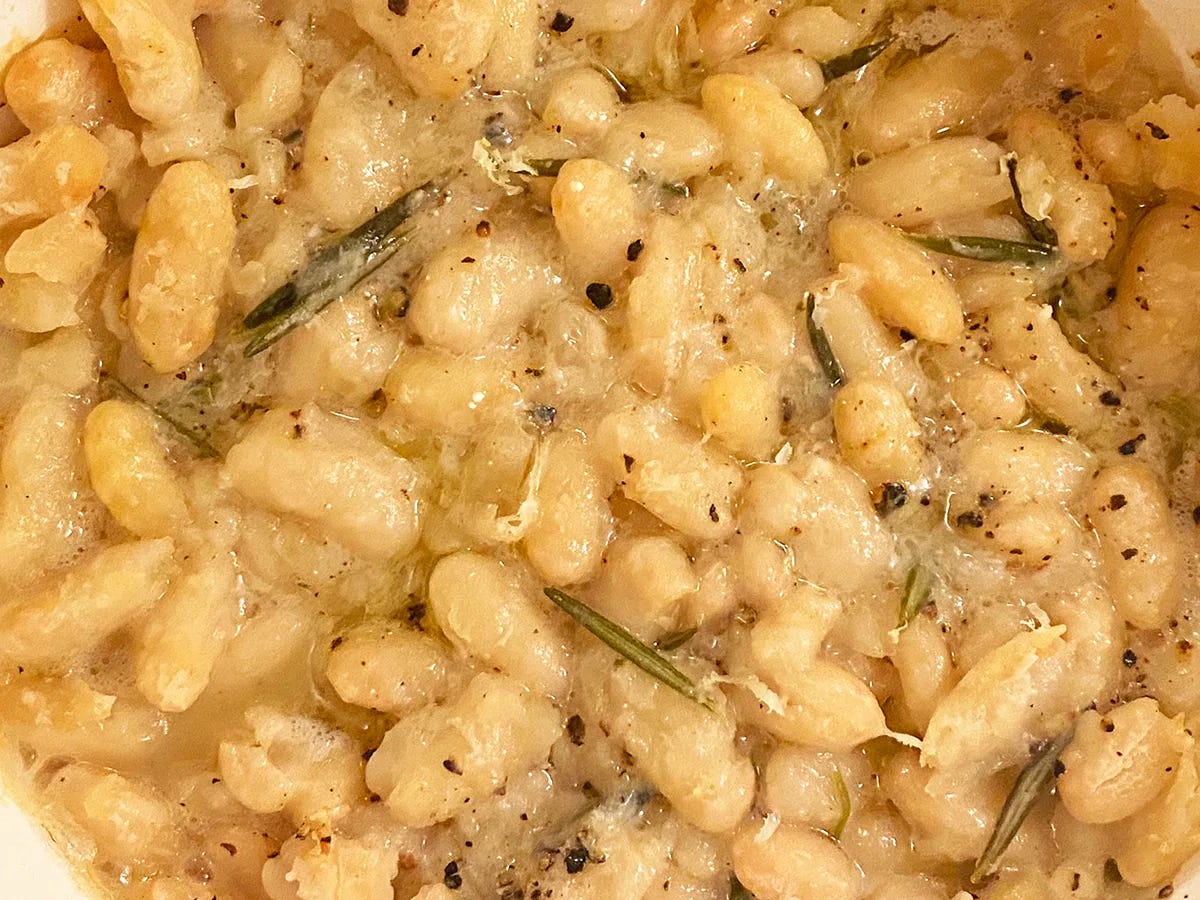Food Notes: 10/21
Tuscan-style white beans, pumpkin spice, sausage casings, and more
Cannellini beans are an integral part of Tuscan cuisine. Nearly every restaurant we ate in this past summer had some variation on the simple bean dish involving olive oil, black pepper, and rosemary.
Cannellini beans are essentially a white kidney bean, and there are numerous related Tuscan varietals. The schiaccione varietal are common in the north around Lucca. One of our best meals was a Restorante Vipore, just north of the city. The above were described as “farmer’s beans baked in a flask.”
The more desirable varietal from the region is the Sorana, named after the municipality in Tuscany where its grown. Genuine Sorana’s are hard to find, even within Tuscany, particularly since 2002, when the bean gained protected geographical indication (PGI) certification owing to the unique conditions and microclimate where it was grown.
Italians love adding food designations to protect rare foods and create artificial price increases. The same bean grown on the wrong side of an arbitrary line simply cannot receive the designation, and is just a white bean. Fraud is rampant, given the differential in price between cannellini beans and Sorana beans.
Bean King Steve Sando started growing the Sorana varietal in California, branding his the Marcella, after Marcella Hazan, who introduced him to the bean. Since they are not grown in the PGI zone, they cannot bear the name. However, Hazan believed the Sorana bean was the most precious bean grown in Italy, and was quite satisfied with the version grown in California.
It’s a bit ironic of course that Sando went to Italy to find the bean only to bring it back to the United States. Cannellini beans all originated in the Americas and arrived in Europe during the Columbian exchange. They arrived in Tuscany in the 16th century, where they became a staple, particularly among the poor farmers. The healthful benefits associated with beans, and the slow foods movement celebrating local products, have both contributed to a resurgence of beans.
We ordered beans almost every night while eating through Tuscany. Each restaurant brought some variation to the basic recipe, although dominate flavors were always rosemary, and to a lesser extend, black pepper.
So it was inevitable that along the way we would end up with a bag of beans to take home. Dried beans are generally allowed across the border, provided you declare them.
We cooked the the bag to add to soup we made last week, but I only used half the beans leaving just enough leftover beans for a go at recreating the baked Tuscan dish. The beans are very much a side dish, but since I was cooking up bucatini carbonara and didn’t have much else, the beans seemed like an ideal addition.
They had already been cooked with rosemary, but I decided to jazz them up a bit with a little more black pepper and dash of Parmigiano Reggiano and olive oil. I baked them for about ten to fifteen minutes to get a slight crust on the top.
Leftover Tuscan-Style White Beans au Gratin
Ingredients
Half a bag of expensive Italian white beans, cooked
Grated Parmigiano Reggiano
Black pepper
Rosemary
Olive Oil
Instructions
Cook the beans with rosemary ahead of time
Combine with cheese, oil, pepper, and season
Bake in a ceramic dish for 10 to 15 minutes at 425F
The Latest
Who Invented Pumpkin Spice?
Starbucks’s Pumpkin Spice latte turns 20 this year, but that’s not where the flavor originated. Snack Stack dives deep into the history of pumpkin spice, tracing how it went from tasty pie addition to seasonal latte flavor.
Savory Croissants Are The Next Big Thing
Bettina Makalintal takes a look at all the different savory croissants that are suddenly the it thing. These aren’t just ham and cheese baked into layers of pastry dough, either. Makalintal finds examples of all sorts of different croissants from crag rangoon to steak frites.
Why do we go Bobbing for Apples?
Joy Saha at Salon looks into why we started this tradition, and you might be surprised how far back it goes.
California’s Contribution
John Mariani, the Virtual Gourmet, looks at California’s culinary contribution, from foods invented in the state to those popularized there.
Where’s the Beef?
Expensive beef isn’t especially popular it turns out. The price has shot up more than 50% since 2020, not helped by the high tariffs slapped on beef imported from places like Brazil where consumers now eat 76% tariffs. Don’t worry, there’s a plan. Turns out that plan is just to bring cheap beef in from someplace else, like Argentina. The American ranchers, who happily have been gouging consumers while protectionist tariffs kept out cheaper meat, are apparently not happy by the plan.
Imitation Sausage Casings
Traditionally, sausage is made by stuffing meat into a natural casing. Sausage casings are made form animal intestines—sheep, pig, and cow. (The casings are obviously cleaned beforehand). But these are typically expensive, and can be delicate. Katherine Kornei at the New York Times takes a look at some of the alternatives, a cellulose casing made from plants, and another made from seaweed.





